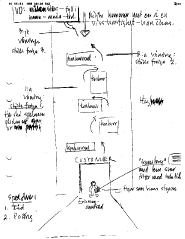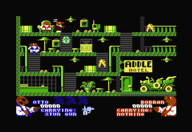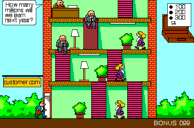 |
The Corporate Ladder: History
|
 |
It's not often that I feel the need to apologize for the quality of my
work, but this is one of those rare occasions. One morning I got a phone call
from a web company that was planning an information campaign within a
subdivision of the Swedish telecommunications corporation Ericsson. They needed
a Java game and they needed it fast. The deadline was only a week away.
 They faxed me a sketch (seen on the right) that outlined the ideas they had been
able to come up with so far. The game would be aimed at people in middle
management, who were meant to learn five company goals for the year 2000 (e.g.
profit and consultant utilization rate). Instead of beating the figures into
people's heads, there was to be a competition. People would have to answer
five questions correctly in order to qualify and someone thought it would be neat
to incorporate the questions into a Java game.
They faxed me a sketch (seen on the right) that outlined the ideas they had been
able to come up with so far. The game would be aimed at people in middle
management, who were meant to learn five company goals for the year 2000 (e.g.
profit and consultant utilization rate). Instead of beating the figures into
people's heads, there was to be a competition. People would have to answer
five questions correctly in order to qualify and someone thought it would be neat
to incorporate the questions into a Java game.
When I say "game" here I'm using the word in a generous sense. Their original idea
would have the main character advance up on the outside of a building, avoiding
competitors represented by falling rectangular blocks. Forget realism or any kind
of meaningful context. Naturally, there was no way I would take on an assignment
like that. But they were open to suggestions for improvement and they gave me
a couple of hours to think about it. If I could come up with something better
and it was possible to build within a time limit suitable for both of us, I would
most likely accept.
I considered a lot of possible ideas. A few things were obvious. For example, there
had to be some sort of cross-sectional view of the inside of the building, and the
competitors had to be shown as real people. The question was how to make the job
of advancing upwards challenging enough. A system of elevators was one option,
but it felt unnecessarily complicated and somewhat illogical.
 After a while I settled for an approach I had used twelve years earlier, in a
Commodore 64 game called Clean Up Service. Simple stairs and enemies that
walked around at random. A wide selection of furniture would make sure it looked
interesting enough. Clean Up Service had a static playing field, though. I had
wanted to build a vertically scrolling version but never gotten around to it.
This seemed like a good opportunity.
After a while I settled for an approach I had used twelve years earlier, in a
Commodore 64 game called Clean Up Service. Simple stairs and enemies that
walked around at random. A wide selection of furniture would make sure it looked
interesting enough. Clean Up Service had a static playing field, though. I had
wanted to build a vertically scrolling version but never gotten around to it.
This seemed like a good opportunity.
 I quickly put together this little sketch of the screen layout. It was
immediately approved and after I had decided on a time budget of 24 work hours
(which included this planning stage) I could get started.
I quickly put together this little sketch of the screen layout. It was
immediately approved and after I had decided on a time budget of 24 work hours
(which included this planning stage) I could get started.
Normally put a lot of effort into the graphics and animation, but this time there
was no room for unnecessary fine-tuning. Everything had to be done fast and look OK
on the first attempt. Hence the black contours. I drew almost everything in
black-and-white and then added simple colors and shadings. The time limit also
meant I couldn't afford to wait for inspiration. When I ran out of furniture ideas
I just grabbed an IKEA catalog and kept going.
And I almost made my own deadline. Developing the game took 26 hours instead of 24
(not counting some last-minute requests, like changing the name of the game from
"The Corporate Ladder" to "Customer.com", for which I charged extra). Although
the quality wasn't up to my usual standards, I'm told the clients were very
pleased with it.
|